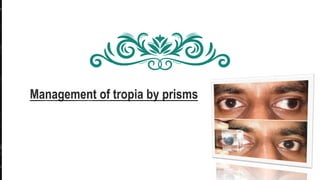
Management of tropia by prisms.pptx
- 2. Hetrotropia is a condition in which one or other visual axis is not directed towards the fixation point . Hetrotropia
- 3. CLASSIFICATION OF STRABISMUS • DIRECTION OF DEVIATION > Hyper deviation > Hypo deviation > Divergent > Convergent .COMITANCY >Concomitant >Incomitant • CONSTANCY >Conestant >entarmitant
- 4. 1. Concomitant 1. Esotropia 2. Exotropia 3. Hypotropia 4. hypertropia
- 5. A solid objective with two l denticalends and flat sides the shape of the ends give the prism a nam such as triangular prism . .Type ofprism : 1. Reliving prism 2. Prism reflex 3.prism bar 4. prism adaptation 5. corrective prism Prism :
- 6. .In order to move the image to where the eye is looking „ thus restoring fixation and binocular vision: For diplopia .Base of the prism is placed over the weak ( or paralyzed muscles) Relieving prism .
- 8. Krimsky test ▪️This test is used to centralize the corneal rflaction in the squinting eye with compared to the fixing eye .
- 9. Prism reflex test (krimesky’s corneal reflex test) 1- objective method . 2- performed at near with point light as fixing target . 3- materials required : prism bar , pen light . 4- useful in large squint .
- 10. 1. Used to investigate BSV and find small angled deviation in infant and children’s. 2. Fixation pattern of fixing eye is studied with horizontal BO prism in front of fellow eye. 3. Same procedure is repeated for next eye too. 4. Commonly used prism is (10▲BO _ 25▲BO) 5. By inducing tropia, fixation preference is studied. Prism reflex test (induced tropia test)
- 11. interpretation
- 12. Hirschberg Corneal Light Reflex: Objectiv assessment of ocular alignment. . Indicates amuscle imbalance.(newborn, young children). . Need apen light . * Note: -Should be symmetrical. -Asymmetrical indicates an imbalance.
- 13. Corneal light reflex Reflexes symmetric = normal. -reflexes temporally = esotropia -reflexes nasally = extropia.
- 14. - also known as the corneal light reflex test . - is quick and simpl way to check ocular alignment. - this assessment is particularly useful for testing for strabismus. - in newborns, young children, patients with poor vision, patients that are not able to fixate or track well. - or in any situation where a full motility evaluation is not feasible. Hirscheberg Test (cont) :
- 15. measurement and the gold standard in measuring strabismus, i.e. ocular misalignment, or a deviation of the eye. Prism cover testis an objective
- 16. - :Measures manifest component only Utilises cover - uncover - Used for a patient who has underlying latent deviation in addition to a small manifest deviation ( i.e. microtropia ) Simultaneous prism cover test
- 18. 1 –Case history 2 –Refraction 3 –Visual acuity 4 –Cover test 5 –Connvergance 6 –Binocular function Investigation
- 19. :some children with esotropia manifest only aproportion of their full angle of squint and if they are corrected either whith prisms or surgery the will increase to this full angle . preoperative prism adaptation helps to diagnose the maximum angle of deviation and potential for abinocular result in these children it is most useful in those who ,on testing , can be shown to demonstrate peripheral fusion at an angle great than their angle of deviation these patients fusion at an angle rected surgically if they were not prism and the amount of surgery is there fore correspondingly increased it is therefore important to know the full angle of squint before surgical intervention . Prism adaptation test
- 20. - correct the refractive errior and treat amblyopia if present -the angle of deviation often reduces following amblyopia treatment resulting in fewer cases that actually require surgical managment for the strabismus -surgery may be for acorrective or functional result Corretion of tropia by prisms
- 22. You can find me at: @username myemail@mohamed abdelmonem.com Any questions? !